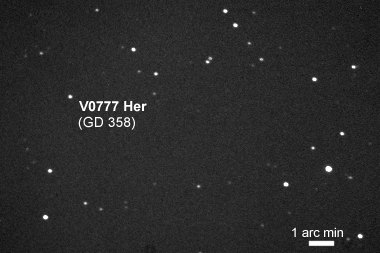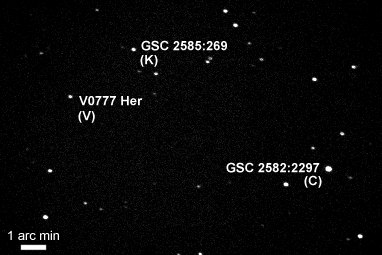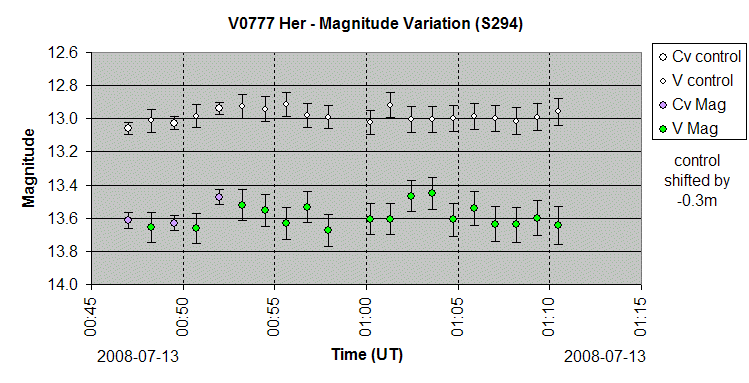David's Astronomy Pages
|
Images (S293) |
Images Sessions |
Home Page |
Images (S295) |
|
Objects Session Notes
V777 Her (GD 358) - Pulsating White Dwarf Astrometric & Photometric Monitoring - SS Cyg (dwarf nova)
- V2491 Cyg (nova)
- U And, W And, U Her, SS Her (mira variable)
- BL Lac (blazar)
- RX And, Z And, RU Peg, R CrB, DY Per (variables)
- Barnards Star, Groombridge 34, Ross 248(Nearby Stars)
Attempts at SS Cyg, V2491 Cyg, AM Her, Groombridge 34 failed due to cloud
- Late evening/night session (3.4hr) - operated under automated control - Occasional passing thin cloud - CCD operation of -20 degC
(at 80% average cooling).- main objective was to collect baseline images of pulsating white dwarf GD 358 (V777 Her) and to acquire images of certain selected stars for ongoing photometric and astrometric analysis in particular U And, W And
V777 Her (GD 358) is a pulsating white dwarf
whose luminosity varies due to non-radial gravity wave pulsations. Variations in
light output (or around 10-15%), arising from a superposition of several
vibrational modes with periods of hundreds to thousands of seconds. The
star has helium dominated atmosphere/spectral type DB and forms a group of stars
know as ZZB, DBV or V777 Her stars.
[ GD
358 Paper 1 , GD
358 Paper 2 ]
A set of baseline images were collected using C and V filters.
| V777 Her / GD 358 (Hercules) |
 |
| Annotated CCD Image 3 x 60s (average combine), 2x2 binning, C Filter 2008-07-13 00:50 hUT (#294120-24) |
| V777 Her - reference stars |
 |
| Annotated CCD Image 60s, 2x2 binning, C Filter 2008-07-13 00:48 hUT (#294120) |
| V777 Her -
photometric test run A short test run over 25 minutes indicates possible variation of V777 Her with two peaks separated by around 6 minutes (variability of V777 Her values greater than noise in control star values) The magnitude error bars associated with 60s V filter exposures (derived from S/N measurements) are too wide to give useful results moving forward. Whilst longer exposures would have higher S/N and thus smaller error bars the data points would be too sparse to capture the expected rapid variations. Initial points with 60s clear filter exposures have higher S/N and consequently lower error bars and seem more appropriate for future photometric runs on this star |
 |
| C Filter: 60s, 2x2 binning (#294120-26) V Filter : 60s, 2x2 binning (#294121-40) |
Back to Top
Images collected for Astrometric Monitoring
of Nearby Stars Project
Images collected for Photometric Monitoring
of Variable Stars
Back to Top
| This Web Page: | CCD Images - Session 294 (2008-07-12) |
| Last Updated : | 2015-05-16 |
| Site Owner : | David Richards |
| Home Page : | David's Astronomy Web Site |